The First National Bank Of Central City
The First National Bank Of Central City in Colorado printed $648,750 dollars worth of national currency. That is a high amount, but condition and serial numbers can make otherwise common currency from this bank quite valuable. This national bank opened in 1873 and stopped printing money in 1933, which equals a 61 year printing period. That is considering a long operation period for a national bank. During its life, The First National Bank Of Central City issued 19 different types and denominations of national currency. We have examples of the types listed below. Your bank note should look similar. Just the bank name will be different. For the record, The First National Bank Of Central City was located in Gilpin County. It was assigned charter number 2129.
We buy all national currency. Please call or email us for a quote. Sales@AntiqueMoney.com
The First National Bank Of Central City in Colorado printed 2,100 sheets of $1 original series territorial national bank notes. Many territorial banks had outputs in the 2,000 to 4,000 range. When dealing with any first charter one dollar bank note, you can always take the number of sheets printed and multiply it by three to get the total number of actual bank notes printed for this denomination. These are technically called original series one dollar territorial national bank notes. Most collectors just call them territorial aces. Believe it or not, they are actually quite available. Around 100 of them are known to exist. Thanks to small hoards from towns like Salt Lake City, Yankton, and Denver, a collector can buy a nice looking territorial ace without spending tens of thousands of dollars. The rarest examples will certainly still cost more than $10,000, but others can seem like bargains.
Original Series $1 Territorial National Bank Note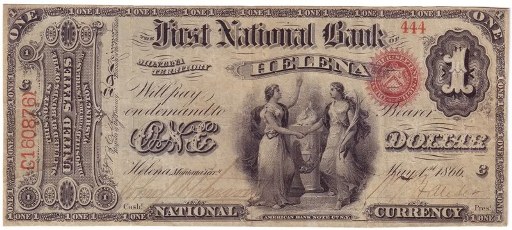
The First National Bank Of Central City printed 2,100 sheets of $2 original series territorial national bank notes. Keep in mind that there was just one two dollar bill printed per sheet. So in this case the sheet number equals the total output of notes. Just like with the one dollar denomination, original series $2 territorial bank notes have survived at a surprisingly high rate considering they were only issued by 19 different national banks. The good news for sellers is that these are still really valuable. Prices are as low as $10,000 for something ugly and relatively common. It is possible for the rarest examples to be worth more than $50,000.
Original Series $2 Territorial National Bank Note
The First National Bank Of Central City also printed 2,475 sheets of $5 original series territorial national bank notes. Many territorial banks had outputs in the 2,000 to 4,000 range. You can do some quick math and take the sheet output, multiply it by four, and get the total number of original series $5 territorial bank notes issued by this bank. Only 30 banks in the country even printed these notes. Today there are only about ten surviving examples known to exist. Most of them are low grade and they are rarely available on the collector market. We are talking about bank notes printed before 1875, so the number of new discoveries being found 140 years later is minimal. Prices range from a few thousand dollars to tens of thousands of dollars based on any number of valuation factors.
Original Series $5 Territorial National Bank Note
The First National Bank Of Central City also printed 1,220 sheets of $1 series of 1875 territorial national bank notes. A total sheet output in the lows 1,000s is a great sign that you own a very rare bank note. Series of 1875 one dollar territorials are very rare. You have to remember that first charter $1 bills were only printed until 1878. So we are talking about just a three year production window. It is no surprise that only five notes of this type are known to exist – all of which happen to be from Santa Fe. A total of five national banks printed series of 1875 $1 bills.
Series of 1875 $1 Territorial National Bank Note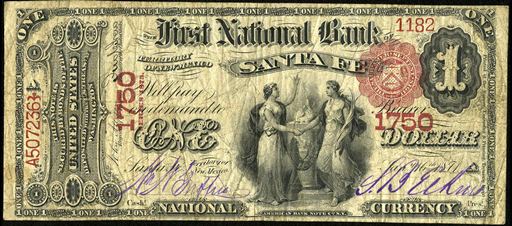
The First National Bank Of Central City also printed 1,220 sheets of $2 series of 1875 territorial national bank notes. That number also happens to be the exact number of individual two dollar bills printed. As we have established, just four banks printed low denomination ($1 and $2) series of 1875 territorial bank notes. Only one two dollar note is known to exist and it is from Denver. We do not have it pictured. The reality is that most collectors don’t add much of a premium between original series and 1875 bank notes. So while this is certainly an ultra-rarity, it is still going to be worth about the same amount of money as the much more common original series two dollar territorial.
Series of 1875 $2 Territorial National Bank Note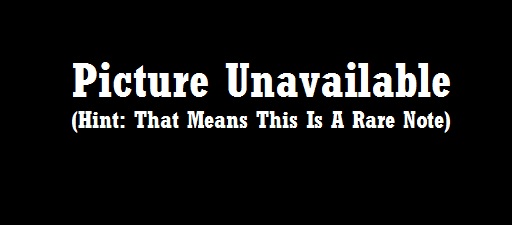
The First National Bank Of Central City also printed 9,050 sheets of $5 series of 1875 territorial national bank notes. That would normally be a very standard output. However, we are dealing with territorials, so everything is still going to be rare. Most first charter five dollar territorials that we encounter today are from the series of 1875. Despite saying series of 1875, these were actually printed as late as 1901 by a handful of banks. So while these might appear ancient, some are much newer than the series date would suggest. With that said, these are still rare items treasured by collectors. Exactly 42 national banks printed series of 1875 five dollar territorials. That list of banks pretty much included all of the territories from Arizona to Wyoming. Please give us a chance to help you establish the value of your note. You will likely be pleasantly surprised with how these bank notes are valued in today’s market.
Series of 1875 $5 Territorial National Bank Note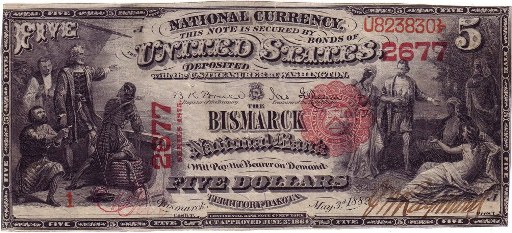
The First National Bank Of Central City also printed 9,105 sheets of $5 series of 1875 national bank notes. A print range between 5,000 and 10,000 is a pretty high number. But you have to remember we are talking about bank notes from the 1870s and 1880s. Even banks with high issue numbers could be rare today. Series of 1875 $5 bills are some of the most commonly encountered bank notes from the first charter series. Only the original series $1 bill is more available. Some banks exclusively issued five dollar bills. So if you want an example from one of those banks then you don’t have many options. These notes have a rounded red seal and red serial numbers. They also all have a red charter number.
Series of 1875 $5 National Bank Note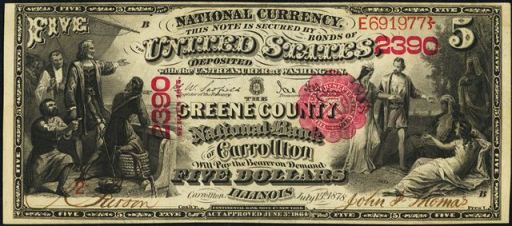
The First National Bank Of Central City also printed 2,175 sheets of $5 1882 brown back national bank notes. That sheet output number is small. Don’t expect too many of these to be available to collectors. You can take the total number of sheets printed and multiply that number by four to get the exact number of 1882 $5 brown back bank notes this bank issued. Each note has a portrait of James Garfield on the left hand side of the bill. These are very popular with collectors because they have different text layouts. Some notes are worth as little as a few hundred dollars, but most are worth a good deal more.
Series of 1882 $5 Brown Back
The First National Bank Of Central City also printed 840 sheets of $10 1882 brown back national bank notes. Very few national banks issued such a small number of 1882 brown backs. There were three $10 bills printed on a single sheet of 1882 brown backs. The design of the bill is similar to all earlier ten dollar national bank notes. The nickname comes from the fact that these bills have a brown seal and brown overprint. Despite saying series of 1882, these were actually printed by some banks up until 1908. The date you see in cursive relates to when the bank first started issuing brown back notes.
Series of 1882 $10 Brown Back
The First National Bank Of Central City also printed 840 sheets of $20 1882 brown back national bank notes. As you can see, the sheet output is the same for $20 brown backs as it is for $10 brown backs. There was only one $20 brown back printed on a sheet. So the sheet output also equals the total note output. One neat thing about all brown backs is that they each have a different back design based on which state issued them. The back left hand side of the note shows the state seal of which ever state the national bank was located in. Generally speaking, 1882 $20 brown backs are pretty difficult to locate. They typically were printed in small numbers and they don’t have a great survival rate.
Series of 1882 $20 Brown Back
The First National Bank Of Central City also printed 1,007 sheets of $5 1882 blue seal national bank notes. 1882 blue seals are traditionally not the most popular national bank notes. However, when we are talking about such a low print number, these become much more desirable. 1882 $5 blue seal bank notes were issued by some national banks in The United States. While these are a somewhat rarer issue, they just aren’t especially popular with collectors. With exception of some minor differences, they look exactly like the earlier brown back series. Most collectors would prefer the brown back notes. With that said, some 1882 blue seals can still be worth thousands of dollars. So don’t just assume that what you have is automatically common.
1882 Blue Seal $5 National Bank Note
The First National Bank Of Central City also printed 709 sheets of $10 1882 blue seal national bank notes. 1882 blue seals are traditionally not the most popular national bank notes. However, when we are talking about such a low print number, these become much more desirable. All of these notes say series of 1882 but they were actually printed between 1908 and 1921. So they aren’t quite as old as the dates might suggest. There is also a date on these notes that is between 1888 and 1901. That date is written in cursive text and it represents when the bank was chartered or re-chartered. Some of the so called 1882 value back notes have a chance to be really rare. Most of the earlier notes that say 1882-1908 on the back are likely going to be relatively common. The designs are exactly the same on the front. Each has a blue seal and charter number.
1882 Blue Seal $10 National Bank Note
The First National Bank Of Central City also printed 709 sheets of $20 1882 blue seal national bank notes. That is the same number of sheets as the ten dollar denomination. You don’t have to multiply by three to get the exact number of notes issued though. There was only one twenty dollar bill per sheet. As with any national bank note, the exact value is still based on the condition, serial number, and bank of issue.
1882 Blue Seal $20 National Bank Note
The First National Bank Of Central City also printed 3,817 sheets of $5 1902 blue seal national bank notes. Many small national banks could be in business for years and only print between 2,500 and 5,000 sheets of blue seals. Ben Harrison is on the front of all 1902 $5 blue seal bank notes. This happens to be the smallest denomination issued for the 1902 series. Each note is complete with a blue seal and blue charter number. Despite saying series of 1902, these were actually issued by national banks between 1908 and 1928. There are two different types of blue seals. The first type is called a date back and it has “1902-1908” written on the back of the bill. The other type is called a plain back; it does not have the date stamps on the back of the bill. The values for these notes range widely based on condition and the bank of issue.
1902 $5 Blue Seal National Bank Note
The First National Bank Of Central City also printed 2,382 sheets of $10 1902 blue seal national bank notes. Most banks that printed such a small number of blue seal bank notes fall into the rare bank category. 1902 $10 blue seal bank notes all have a portrait of William McKinley on them. Values can range from as little as $40 up to over $10,000. There really is no trick to know what is rare and what is common by just doing an internet search. You really need to work with an expert (like us) in order to determine the value of your specific bank note. There are at least ten different factors than can make some 1902 $10 blue seals worth more than others. We know exactly what to look for and we would be happy to provide a free appraisal and our best offer.
1902 $10 Blue Seal National Bank Note
The First National Bank Of Central City also printed 2,382 sheets of $20 1902 blue seal national bank notes. The same rarity rules for 1902 $10 blue seals also apply to $20 blue seals. Just remember that $20 bills are by nature three times rarer (unfortunately they don’t command a premium over other denominations). Hugh McCulloch is pictured on the front of each bill. Contact us if you need pricing help.
1902 $20 Blue Seal National Bank Note
The First National Bank Of Central City also printed 864 sheets of Type1 1929 $5 national bank notes. This is a small print range, but it does not guarantee rarity. Every 1929 $5 bill has a portrait of Abraham Lincoln on it. This is also the lowest denomination of small size national currency that any bank issued. All serial numbers end with the letter A and start with a letter between A and F. Remember that you can take the total number of sheets printed and multiply it by six get to the actual number of bank notes printed for this denomination. All small size national bank notes were printed on sheets of six.
Series of 1929 Type1 $5 National Bank Note
The First National Bank Of Central City also printed 389 sheets of Type1 1929 $10 national bank notes. That may sound like a very small number, and it is. However, when it comes to small size notes, that print range usually allows for a handful of survivors. Each $10 bill from 1929 has a portrait of Alexander Hamilton on it. The black number written vertically is the charter number. The charter number never affects the value; it is just an identifier. The ten dollar type1 national bank note happens to be the single most common national bank note, with over 65,000 known to exist from all banks. Of course each note is valued based on its condition and rarity. Some are very rare.
Series of 1929 Type1 $10 National Bank Note
The First National Bank Of Central City also printed 123 sheets of Type1 1929 $20 national bank notes. That is an extremely small sheet printing number. Survivors are still likely but definitely not guaranteed. Andrew Jackson is featured on the front of each 1929 $20 bill. Be sure to take note of the serial number on your specific bank note. If it is 000001 then you can expect a nice premium. There is a special market for serial number one bank notes. Of course, even if the number isn’t #1, it could still be collectible and have a high value just based on its condition and rarity alone.
Series of 1929 Type1 $20 National Bank Note



